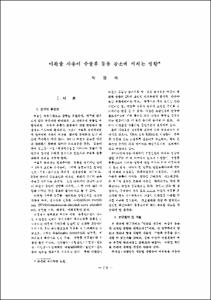이완술 사용이 수술후 동통감소에 미치는 영향
- Affiliated Author(s)
- 박정숙
- Alternative Author(s)
- Park, Jeong Sook
- Journal Title
- 대한간호학회지
- ISSN
- 2005-3673
- Issued Date
- 1985
- Abstract
- Postoperative pain is one of the most frequently occurred pain in hosiptals, but it has been underest-imated because it is only a part of postoperative physiological process and may disappear in time. It is necessary that nurses use the relaxation technique, planning and implementing by themselves independ-ently, to reduce this postoperative pain.
This Study is aimed at showing the effect of rela-xation technique on reduction of postoperative pain, and exploring the factors influencing postoperative pain.
Fifty-seven patients with abdominal surgery who admitted in attached D Medical Center to K Univer¬sity in Daegu have been studied. Of them twenty- nine were experimental group and the remaining twenty-eight were control group. This study has been conducted for collecting data through interviews and observation from August 23 to October 24, 1984.
The tools of this study were two kinds; Postoper¬ative Pain Scale is obtained from a review of refer¬ences by the researcher, and relaxation technique, designed to use postoperative setting adequately, is also obtained from a review of references by the researcher.
After confirming no significant differences between the two groups, the hypotheses were statistically verified by xa-test, t-test, and pearson Correlation Coefficient.
The results of this study are summerized as follows; * The main hypothesis that the experimental group who use relaxation technique will have less degree of postoperative pain than the control group who don't use relaxation technique is devided into three sub-hypotheses.
1. The first sub-hypothesis that the experimental group will have less score of postoperative pain than control group was accepted (t=7.810, p<. 01). Even with controlling pain threshold, showing diff¬erence in some degree between the two groups, the experimental group has less score of postoperative pain than the control group. Therefore this confi¬rms the acceptance of the first sub-hypothesis more strongly.
2. The second sub-hypothesis that the expermental group will have less frequency of analgesics than the control group is accepted (x2=9.85, p<. 01).
3. The third sub-hypothesis that the experimental group will have less variation of pulse, respiration, and blood pressure between pre and post operative periods than the control group is rejected. So this hypothesis is reverified through comparing the variation of pulse, respiration, and blocd pressure
3443:4-S)4 3] 15=4 *fl 15:
between pre and post changing-position to measure the pure effect of relaxation technique. Pulse and respiration is significantly lowered in the experim-ental group (t=7.209, p<.01, t=3.473, pC.Ol), but systolic and diastolic blood pressure is not dif¬ferent significantly between the two groups (t= 1.309, p>. 05, t=l. 727, p>.05). Therefore the third sub-hypothesis is partially accepted.
Conclusively, the researcher thinks that it is nece-ssary that nurses should provide patients with rela-xation technique to reduce postoperative pain, and to increase independence of nursing.
- Alternative Title
- The Effect of Relaxation Technique on Reduction of Postoperative Pain
- Department
- Dept. of Nursing (간호학)
- Publisher
- College of Nursing
- Citation
- 박정숙. (1985). 이완술 사용이 수술후 동통감소에 미치는 영향. 대한간호학회지, 15(1), 76–96.
- Type
- Article
- ISSN
- 2005-3673
- Appears in Collections:
- 2. College of Nursing (간호대학) > Dept. of Nursing (간호학)
- 파일 목록
-
-
Download
 oak-bbb-00072.pdf
기타 데이터 / 1.15 MB / Adobe PDF
oak-bbb-00072.pdf
기타 데이터 / 1.15 MB / Adobe PDF
-
Items in Repository are protected by copyright, with all rights reserved, unless otherwise indicated.